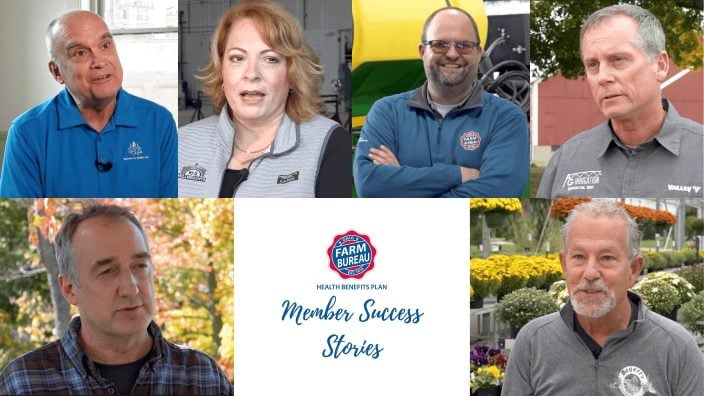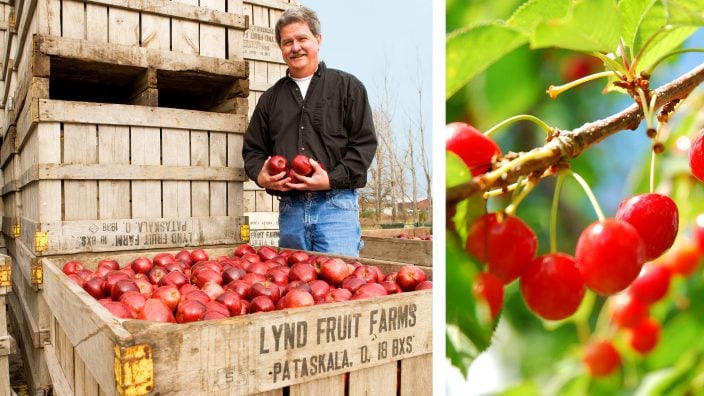Farmer’s Guide to Trucking Regulations available to Ohio Farm Bureau members
The guide includes a farm driver checklist, overview of state and federal regulations and exemptions, CDL qualifications and more.
Read More
The allure of homegrown fruits is long lived. Recall Eve was tempted by the forbidden fruit in the Garden of Eden, legendary John Chapman (Johnny Appleseed) generously planted beloved apple trees for new settlers throughout the Ohio Valley and young George Washington supposedly angered his father when he chopped down his prized cherry tree.
Backyard fruits’ appeal endures today, according to Farm Bureau member Richard Wander, partner of Lynd Fruit Farm in Licking County and previous president of the Ohio Produce Growers and Marketers Association. Wander, who started growing cherries and apples as a kid, went on to study horticulture at Ohio State University and now shares in managing this 500-acre fruit farm that averages 150,000 bushels of apples a year. He still grows a couple of fruit trees in his own backyard and encourages backyard gardeners to try growing their own.
“Some of our best customers are those who grow their own fruit,” he said. “They’re more appreciative customers and have a better understanding of what we do.”
Favorite varieties
For first-time growers, he said the key to success is to plant disease-resistant fruit trees and avoid the higher maintenance ones, such as Fuji, and others prone to apple scab or fire blight. “The worst thing is to bite off too much at first and fail,” Wander said.
GoldRush, a tart yellow apple, and Pixie Crunch, a smaller sweet apple, are two scab-resistant apple varieties that top his list. A little more challenging, but still scab tolerant, varieties include Honeycrisp, the current darling of the apple industry, and Suncrisp, the farm’s best-selling “u-pick” apple.
For pears, Wander recommends Magness or Potomac fire blight-resistant varieties. He said these smaller pear trees are the easiest of all fruit trees to grow. For cherries, he suggests two sour varieties – the semi-dwarf Meteor or the dwarf North Star. Both are resistant to leaf spot, the biggest bane of cherry trees.
Wander doesn’t recommend peach trees for beginners because they’re too vulnerable to Ohio’s cold springs.
For apple and pear trees, Wander reminds growers to plant two or more varieties that bloom at the same time. He explains these fruit trees cannot pollinate themselves, so they rely on another variety – even an ornamental crab apple tree – and the help of bees to pollinate and bear fruit.
Teresa Woodard is a freelance writer from Franklin County.
Getting started
Purchasing a tree:
Tree care:
What makes a good location:
Fruit maturity:
Tree fruits reach maturity at different times, depending on variety and climate. Wander said to monitor the fruits’ color for harvest readiness. The fruits’ undercolor or ground color also can be a good indicator. Watch for the green color to change to a little yellow green then to the respective ripe fruit’s normal skin color.
For more information
Visit Ohio State University Extension’s OhioLine for a list of fruit fact sheets including Growing Apples in the Home Orchard. You also can search for the publications Midwest Home Fruit Production Guide and Controlling Diseases and Insects in Home Fruit Plantings.
If you enjoyed this article, consider signing up for the Our Ohio e-letter and you’ll receive monthly e-letters about your local food community, including seasonal recipes and growing how-to articles and stories.


The guide includes a farm driver checklist, overview of state and federal regulations and exemptions, CDL qualifications and more.
Read More


ODA will enroll 500,000 acres into the program for a two-week sign-up period, beginning April 22, 2024, through May 6, 2024. Contact local SWCD offices to apply.
Read More

Katie Share of Columbus has been named ExploreAg and Youth Development Specialist for Ohio Farm Bureau.
Read More

Mary Klopfenstein of Delphos has been named Young Ag Professional and Ag Literacy Program Specialist for Ohio Farm Bureau.
Read More

The plan has been updated to give sole proprietors access to more rate stability and a smart solution that offers potential savings on health care.
Read More

The American Farm Bureau Federation, in partnership with Farm Credit, is seeking entrepreneurs to apply online by June 15 for the 2025 Farm Bureau Ag Innovation Challenge.
Read More

Adele Flynn of Wellington has been elected treasurer of the Ohio Farm Bureau Federation and now holds the third highest elected office in Ohio’s largest and most influential farm organization.
Read More

Producers are urged to work with their veterinarian to practice enhanced biosecurity measures and review and limit cattle movements within production systems.
Read More

The changing seasons bring with them the need to thoroughly inspect pole barns for any damages that may have occurred during the winter months.
Read More

Hundreds of Ohio businesses and sole proprietors are raving about Ohio Farm Bureau’s Health Benefits plan with lower, predictable costs and easy enrollment and administration options.
Read More